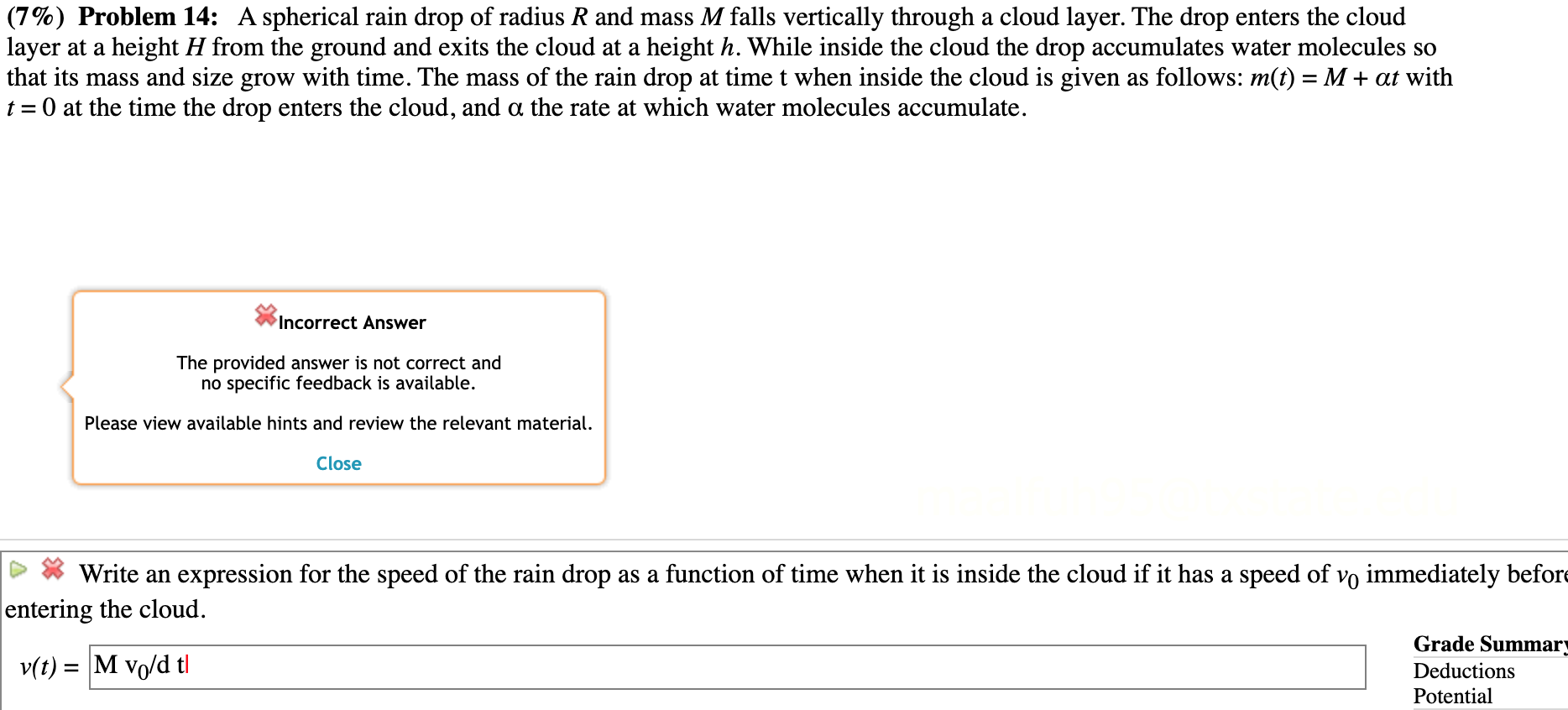
- #Calculate the velocity of a spherical raindrop plus
- #Calculate the velocity of a spherical raindrop free
The terminal speed of an object changes due to the properties of the fluid, the mass of the object and its projected cross-sectional surface area.Īir density increases with decreasing altitude, at about 1% per 80 metres (260 ft) (see barometric formula). V t = 2 m g ρ A C d in this and subsequent formulas. Using mathematical terms, terminal speed-without considering buoyancy effects-is given by So the resistance to falling in the case of the small animal is relatively ten times greater than the driving force. Divide an animal's length, breadth, and height each by ten its weight is reduced to a thousandth, but its surface only to a hundredth. For the resistance presented to movement by the air is proportional to the surface of the moving object. A rat is killed, a man is broken, a horse splashes. You can drop a mouse down a thousand-yard mine shaft and, on arriving at the bottom, it gets a slight shock and walks away. To the mouse and any smaller animal presents practically no dangers. Ĭompetition speed skydivers fly in a head-down position and can reach speeds of 150 m/s (490 ft/s) the current record is held by Felix Baumgartner who jumped from an altitude of 38,887 m (127,582 ft) and reached 380 m/s (1,200 ft/s), though he achieved this speed at high altitude where the density of the air is much lower than at the Earth's surface, producing a correspondingly lower drag force. 30-06 bullet dropping downwards-when it is returning to the ground having been fired upwards, or dropped from a tower-according to a 1920 U.S. The same terminal speed is reached for a typical. In this case, the terminal speed increases to about 90 m/s (300 ft/s), which is almost the terminal speed of the peregrine falcon diving down on its prey. Higher speeds can be attained if the skydiver pulls in their limbs (see also freeflying). In this example, a speed of 50% of terminal speed is reached after only about 3 seconds, while it takes 8 seconds to reach 90%, 15 seconds to reach 99% and so on. This speed is the asymptotic limiting value of the speed, and the forces acting on the body balance each other more and more closely as the terminal speed is approached.
#Calculate the velocity of a spherical raindrop free
Graph of velocity versus time of a skydiver reaching a terminal velocity.īased on wind resistance, for example, the terminal speed of a skydiver in a belly-to-earth (i.e., face down) free fall position is about 55 m/s (180 ft/s). Air pollution and fog are examples of convection currents. For very small objects such as dust and mist, the terminal velocity is easily overcome by convection currents which prevent them from reaching the ground and hence they stay suspended in the air for indefinite periods. This is because the downward force (weight) is proportional to the cube of the linear dimension, but the air resistance is approximately proportional to the cross-section area which increases only as the square of the linear dimension. In general, for the same shape and material, the terminal velocity of an object increases with size. An object with a large projected area relative to its mass, such as a parachute, has a lower terminal velocity than one with a small projected area relative to its mass, such as a dart. Drag depends on the projected area, here represented by the object's cross-section or silhouette in a horizontal plane. An object moving downward faster than the terminal velocity (for example because it was thrown downwards, it fell from a thinner part of the atmosphere, or it changed shape) will slow down until it reaches the terminal velocity. At this point the object stops accelerating and continues falling at a constant speed called the terminal velocity (also called settling velocity). At some speed, the drag or force of resistance will equal the gravitational pull on the object (buoyancy is considered below).

Īs the speed of an object increases, so does the drag force acting on it, which also depends on the substance it is passing through (for example air or water).

In fluid dynamics an object is moving at its terminal velocity if its speed is constant due to the restraining force exerted by the fluid through which it is moving.

Since the net force on the object is zero, the object has zero acceleration. It occurs when the sum of the drag force ( F d) and the buoyancy is equal to the downward force of gravity ( F G) acting on the object. Terminal velocity is the maximum velocity (speed) attainable by an object as it falls through a fluid ( air is the most common example). The net force on the object is zero, and the result is that the velocity of the object remains constant.
#Calculate the velocity of a spherical raindrop plus
The downward force of gravity ( F g) equals the restraining force of drag ( F d) plus the buoyancy.


 0 kommentar(er)
0 kommentar(er)
